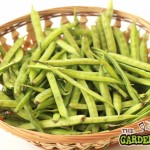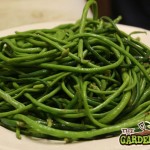Crop rotation is both essential and simply to do, so why is it that so few of us do it?
- Green Beans
- Green Beans
- Green Beans
Rotating vegetables is essential for three reasons:
- To conserve soil nutrients and fertility
- To prevent the build up of pests and soil borne diseases
- To add nutrients to the soil
Really any one of the above reasons is reason enough to practice crop rotation and without doing it you can quickly see that the soil in which you grow your crops can easily become unproductive. The benefit of including beans and peas on your vegetable is also essential step in good crop rotation.
Beans are part of the legume family of plants and are in the legume crop rotation group. They have been given their own group because they are very special plants; Legumes in fact add nutrients to the soil. They do so by the bacteria which live on their roots which convert atmospheric nitrogen into available nitrogen which plant roots can then absorb (nitrogen fixation). Rotating the legume and beans around your vegetable plot allows these plants work their magic on each part of the plot increasing available nitrogen throughout. Nitrogen is the single most important nutrient in the soil and can often be lacking because of the lack of nitrogen fixation. Soil pH and water content can also influence levels of nitrogen fixation as highly acidic soils and damp soils lack the bacteria which fix nitrogen.
While Beans add nutrients to the soil other plants consume it at a very fast rate. For example the brassica family of vegetables are hungry feeders and deplete nitrogen fast to build up their build juicy green leaves. If brassicas are grown in the same location year after year the nutrient content of the soil will deplete. It would then be recommended to grow brassicas after beans in your plot.
Crop rotation groups:
Allium family
- Onions
- Garlic
- Leeks
- Shallots
- Scallions
Brassica Family
- Cabbage
- Broccoli
- Brussels Sprouts
- Kale
- Cauliflower
- Turnips & Swedes
Legume Family
- Peas
- Beans
- Mange touts
Root crops:
- Carrots
- Parnsips
- Beetroot
- Potato
How to rotate:
Divide your plot into four sections. Grow vegetable from each group together and over a four year cycle rotate each group around the plot so that no section will grow the same group twice within a four year period.
Sticking to the plan can be difficult in that its hard to fill a section with only allium plants while another section may require more space as you try to grow potatoes carrots and parsnips in the one year. With that in mind consider not growing potatoes every year and give the soil a chance to recover and remove any traces of potato blight from your plot. Another reason why rotation can be difficult would be that the different groups require different soil types. However you can say within reason that most vegetables prefer a light, well drained soil with plenty of well rotted farm yard manure and soil that have been well dug and with a pH of neutral to slightly acidic.


